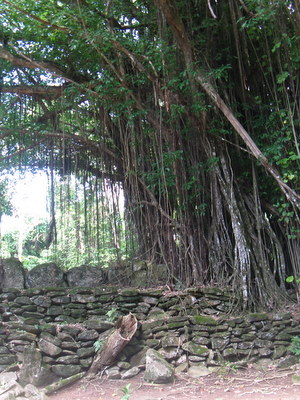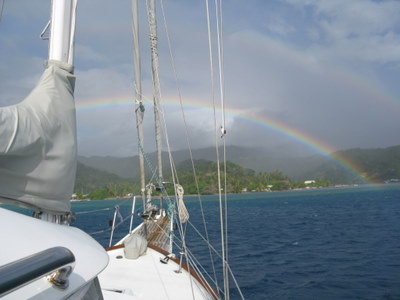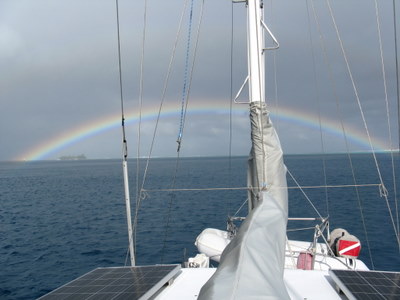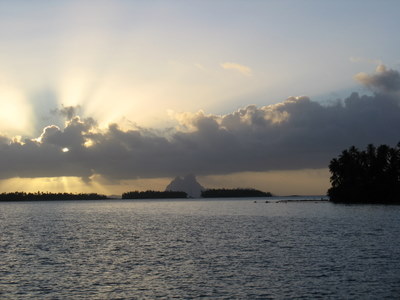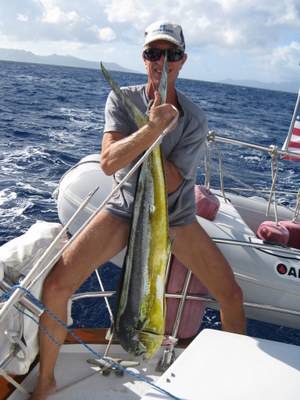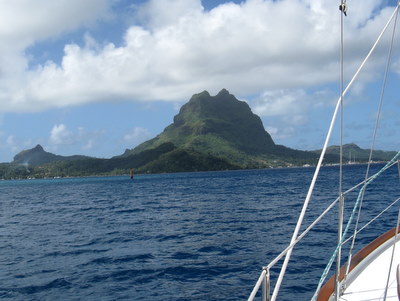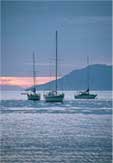
Current Location
(enter callsign KG6NNZ)
Logbook: French Polynesia - Leeward Society Islands (Iles Sous le Vent) -
Huahine,
Raiatea, Tahaa and Bora Bora - June & July, 2011
| It was with some reluctance that
we pulled ourselves away from the atolls of the Tuamotus where we had spent the
past couple of months, but since we were headed to the Leeward
Society Islands of French Polynesia, we were leaving with high expectations for
the next several weeks. At this time, many of the cruising
yachts in French Polynesia were headed to Papeete for the upcoming "Puddle Jump
Rendezvous" put on by Latitude 38 magazine. Although the party sounded
like fun, we gave it a pass since we had already visited Tahiti and Moorea, and
we had other destinations in mind.
The Leeward Islands of French Polynesia, or Iles Sous le Vent as they are called in French, are comprised of Huahine, Raiatea-Tahaa (sister islands sharing the same lagoon), Bora Bora, Maupiti, and a few other small and mostly uninhabited atolls. The easternmost of these islands, Huahine, is situated 100 miles west-northwest of Tahiti. The Leewards are high islands of volcanic origin and are for the most part surrounded by a navigable lagoon, which is sheltered from ocean swell by a barrier reef. Although the Windward Islands of Tahiti & Moorea were annexed by France in 1842, the Leeward Islands were not annexed until 1888, and the annexation did not come without a fight. Local chiefs refused to sign the annexation treaty until 1895, and resistance continued until 1897, when the islands were finally overcome by force. French citizenship was not extended to the inhabitants of these islands until 1945. |
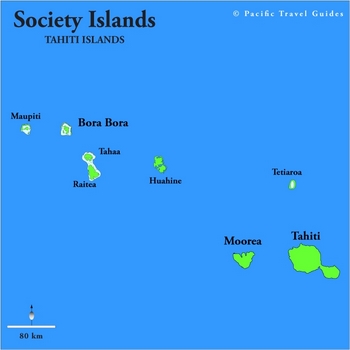 |
Passage from Rangiroa, Tuamotus, to Fare, Huahine (June 13-15, 237 nm, 47½ hours). When we departed Rangiroa, we had a well-timed and easy departure with calm waters in the Avatoru pass. We followed our friends Chris & Belinda on Nahanni out the pass, and a couple hours later, we said our good-byes via the radio as they turned south toward Papeete, and we continued on a more westerly course toward Huahine. We had a lovely moon the entire passage and good sailing winds for the first half of the trip, but late in the morning of our second day at sea, the winds started to die out. We flew our spinnaker for a few hours, which we hadn't done in a long time, but by the afternoon, there wasn't enough wind to keep it full, and we turned on the engine and motored the last 15 hours of the trip. We arrived at Huahine early in the morning, and as we approached the island, both of us commented on the lovely smell coming from it - a mixture of earth, fruit, flowers and other flora - very nice! Although the Society Islands also have barrier reefs surrounding them, the currents coming in and out of the passes are not as strong as the Tuamotus, and one can come and go pretty much at any time. We motored in the pass and dropped our anchor off the town of Fare (pronounced FAR-ay).
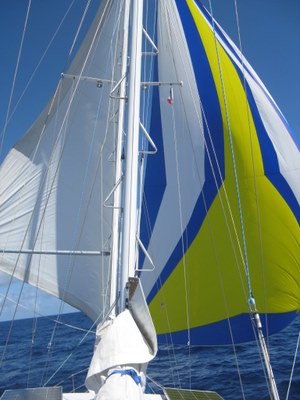 Sailing Slip Away with her spinnaker and headsail |
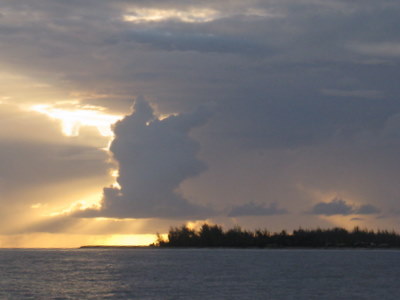 Sunrise as we round the northern end of Huahine on the morning of our arrival |
| Huahine. Huahine is
the easternmost of the Leeward Islands, and it is
comprised of two islands - Huahine-Nui and Huahine-Iti (big and little), which
are connected by a bridge. These islands are quite rural with only a few resorts,
and the population of 5,500 is mostly Polynesian. Some of the strongest
resistors to French rule came from this island, and much of the population still
favors independence. Fare is the
largest town on Huahine, and it is located near the Avamoa Pass on the northwest side of Huahine-Nui. Fare, Huahine (June 15-21). Our first order of business in Fare was re-stocking Slip Away with food and fuel, and after making sure that our anchor was set well, we went off in search of the grocery store. We'd heard there was a good supermarket here, and it was even better than we anticipated with aisles and aisles of food. (Of course, the fact that we hadn't seen a decent grocery store in over two months probably influenced our perception!) We made daily trips to the grocery store over the next several days (sometimes twice a day), as we restocked the stores of food we had depleted over the past couple of months. An added bonus to this nice grocery store was that when we arrived, beer was on sale! In the Tuamotus, we had become accustomed to paying almost $3 US per half-liter bottle. Here, a case of 20 was on sale for 3500 francs, so that was about $2.20 each - still not cheap, but much better! Additionally, there was a small farmers market each morning along the street in front of the supermarket. Although there wasn't a wide variety of items to choose from, it was good enough, and fresh fruits and vegetables were once again affordable. Also, the gas station was close by, so we could fill up our jerry jugs with gasoline, which we needed for the dinghy and our dive compressor. We were also quite pleased with the speedy internet connection in this anchorage. Since most of the other cruising yachts were in Papeete, there were only a few of us using the wifi here. It was fast enough to do a Skype phone call, which came in handy for us so we could call Mom in Ohio and also communicate with ICOM about the repair of our SSB radio and make arrangements to have it shipped back to us. |
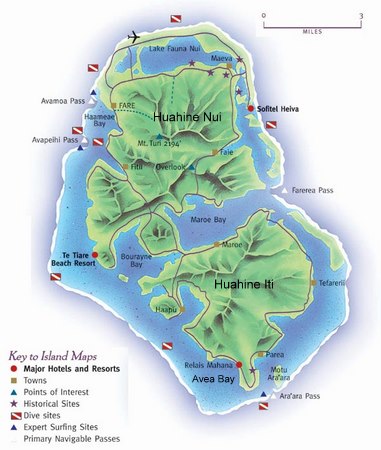 |
Anchored fairly close to us in Fare was a boat named Gromit. We had never met the family on Gromit, but we knew their boat name from the radio because we had sailed from the Galapagos to the Marquesas in close proximity to one another last year. We had heard from mutual friends that Gromit had spent the hurricane season in Huahine, and their kids went to school here. Shortly after arriving in Huahine, we dinghied over to introduce ourselves to Cornelia, Mike and the kids - Zoe (13), Maia (10) and Liam (7). Although this family is Canadian, Cornelia was born in Germany, and since she had a European passport, the family was able to take advantage of much less stringent length-of-stay limitations extended to Europeans versus North Americans. They are a super nice family, and Cornelia & Mike gave us some great advice for getting our SSB radio shipped to us here.
We spent our first three days in Fare in an anchorage just inside the pass, and the first couple of nights it was quite comfortable. However, there was some rough weather headed our way and an increasing southwest ocean swell, which was coming straight in the pass. The surfers were loving it, but by our third night here, Slip Away was rocking and rolling. We had some information about a nearby anchorage which was recommended for conditions such as these. It was still close to town but offered better protection from the swell - so we moved. It was true that we didn't feel the ocean swell in this new location, but we had other issues here. First, there was a very strong current inside the barrier reef due to the large swell on the outside. This made Slip Away face into the current and lie sideways to the wind, which by this time was also blowing quite strong and coming down the side of the mountain in strong gusts (often 25-30 knots). At times these gusts of wind heeled us over about 20 degrees and at others, it sent us sailing forward, backward and occasionally in circles. The end result was that although we had dropped our anchor in a nice sandy area, we had sailed forward into a patch of coral heads, and we were completely tangled in them. Before leaving here, Rich spent about 45 minutes under water in his scuba gear untangling our anchor chain, and then we still had to use the engine to back off one coral head which we had wrapped around several times. But we finally broke free, weighed anchor and moved on to explore more of Huahine.
Bourayne Bay (June 21 to 22). When we left Fare, we traveled along the lagoon inside the barrier reef and headed just five miles south to Bourayne Bay. We anchored outside the bay and found the currents in the lagoon and the winds coming off the mountains to be much gentler here. We spent the afternoon snorkeling around Motu Vaiorea at the entrance to the lagoon, and although it was not Tuamotus-quality snorkeling, it was quite nice. We saw quite a few shrimp gobies, and Rich found a beautiful cowrie shell that had no living creature inside, so it is now on display in Slip Away's salon. After snorkeling, we took a dinghy ride up into the bay, which had beautiful mountains surrounding it, and found the bridge which connects Huahine-Nui and Huahine-Iti. This area was worth some additional exploring, but we needed a reliable internet connection for communication about the status of our SSB radio, so the next day we weighed anchor and continued further south to Avea Bay, with the thought that we could stop here again on our way back to Fare.
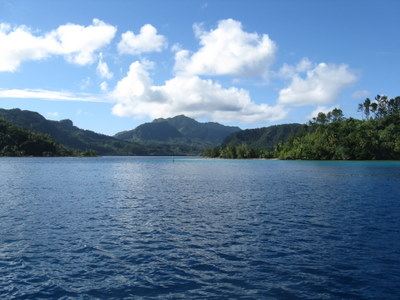 Bourayne Bay |
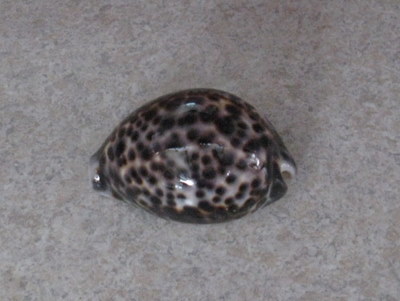 Beautiful cowrie shell that Rich found while snorkeling |
Avea Bay (June 22 to 28). From Bourayne Bay, we motored down to Avea Bay at the southwest corner of Huahine-Iti, just 8 miles away. Avea Bay was a favorite spot for many of the cruising yachts in last year's fleet, and we also really enjoyed it. It was windier here than at our anchorage outside Bourayne Bay, but the waters of the bay were protected from all but some small wind chop. There were a couple other boats anchored here, but it was a large bay with plenty of room. Ashore were a couple of small guesthouses and restaurants.
The first thing we did here was to go for a walk to check out the area - we stopped at Marae Anini, a small site of temple ruins dating back to the 1300's, and we visited the small town of Parea. There was a small store (magasin) along the road between the anchorage and the town of Parea, and we stopped in to see what they had in stock. We were hoping we could buy an ice cream bar, but we were out of luck. We asked if we could buy baguettes in the morning, and they told us yes - if we showed up at 5 a.m. (we didn't want bread that badly!). The shelves of this store were some of the barest we've ever seen, but some of their stock surprised us, especially the four bottles of "Sun-In" priced at $15 each. Do the Polynesians really use Sun-In to lighten their hair???
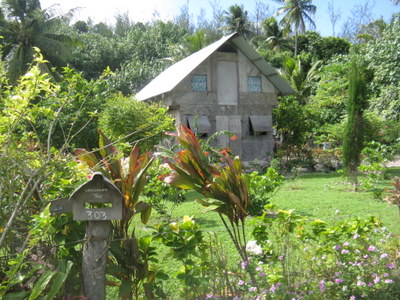 Polynesian home along the road near Parea |
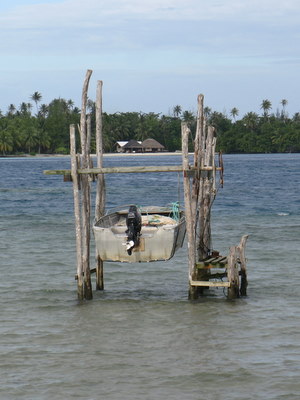 A rustic boat lift in Parea Village facing a modern home across the bay on Motu Araara |
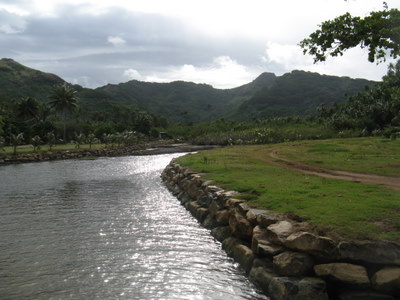 River valley in Parea |
We found lots to do in this area over the next few days. There was an excellent hike on a trail which took us along the ridge of the island's southern peninsula, with beautiful views of both sides of the coast. The first time we did the hike, it was cloudy and rained on us, but a couple days later, we packed a picnic lunch (pâté, brie cheese and crackers) and did the hike again. This time it was a sunny day, and our pictures were much more vivid.
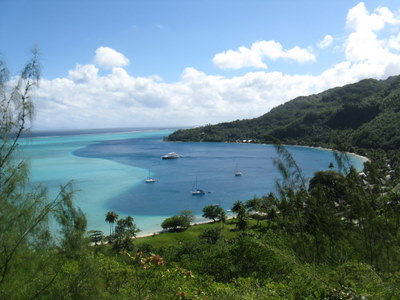 View of Avea Bay from the ridgeline |
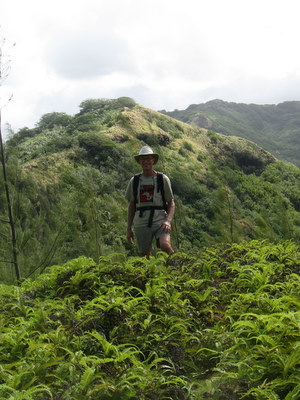 Rich hiking the ridge at Huahine's south end |
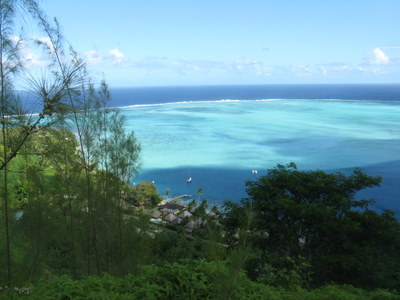 Beautiful view of Huahine's barrier reef |
Some of Huahine's beautiful flora:
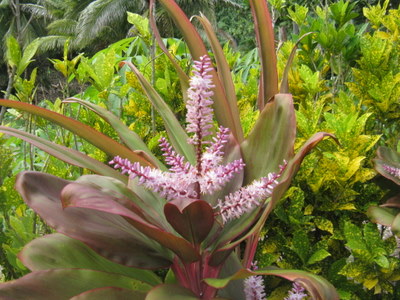 |
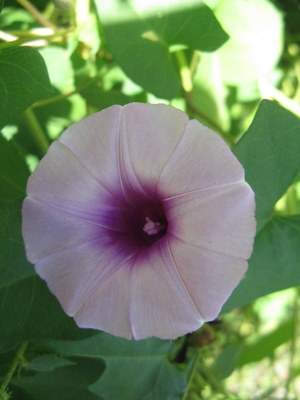 |
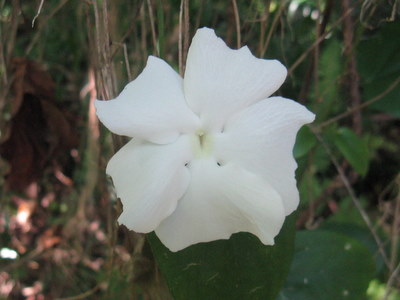 |
While here, we also did some snorkeling in the bay where we were anchored, and although visibility wasn't great, the fish life was good. The longer we stayed at Avea Bay, the calmer the weather became, and on one of our last days here, we dinghied around the southern tip of the island to a dive site just inside the Araara Pass. We didn't take our tanks, but we snorkeled among some very pretty corals, and again, the fish life was good.
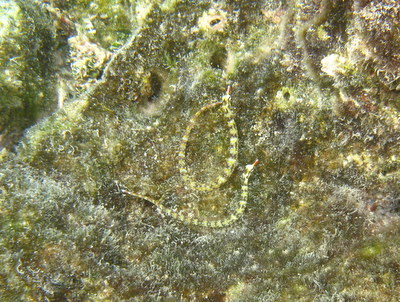 Pipefish sighted while snorkeling inside Araara Pass |
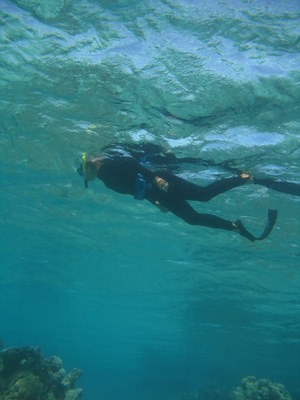 Jan snorkeling in the clear blue waters |
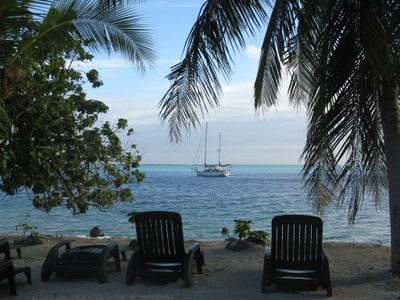 A postcard-like photo of Slip Away anchored at Avea Bay |
Our friends Roger & Marion on Marionette IV arrived in this anchorage a couple of days after us, and one evening the four of us went out for dinner at Relais Mahana, one of the guesthouses ashore. (Our French dictionary defined "relais" as a "truckstop", but this was anything but!) Dinner at restaurants in French Polynesia is pretty pricey, so this was a splurge for us, but we had an anniversary coming up and thought we could treat ourselves to a nice dinner. The main courses of tuna with vanilla sauce and steak with blue cheese sauce were delicious, but our favorite part was the profiteroles with chocolate sauce for desert. Yum!
The SSB Radio. While we were enjoying Avea Bay, we stayed "connected" with wifi internet, which allowed us to track the progress of our SSB radio. If it sounds like we were preoccupied with the radio repair - we were. We don't have a satellite phone, so when we are offshore or away from an internet connection, we use this radio to get weather information and send and receive email to stay in touch with our family and friends. When we want to talk to our cruising friends, we don't call them on a cell phone, we set up a time and frequency to chat on the radio. We could often find wifi signals while cruising in French Polynesia, so we could use the internet for weather information and email. But after French Polynesia, we would be heading to more remote locations, and we needed a functioning radio.
The radio was repaired quite quickly, and per our request, ICOM shipped it back to us via UPS. UPS called their method of shipping our radio "Worldwide Saver". It cost a small fortune to ship this 12 lb. box to us, so we're not sure where they got the "saver" part, but our radio got quite a world tour. It went from Seattle, to Los Angeles, to Hawaii, to Australia, to New Zealand, and Papeete before it finally found its way to us in Huahine.
Prior to ICOM shipping the radio to us, we had contacted the local UPS agent in Papeete (J.A. Cowan & Fils) to get exact shipping instructions, and we found the folks in this office to be very helpful. Our contact at J.A. Cowan asked us to send her the tracking number once the radio shipped, and then she also asked for copies of some other documents (boat registration, passport copies, etc.), so they would have what they needed to clear the item through Customs when it arrived in Papeete. The radio actually arrived in Papeete a couple days earlier than we anticipated, and the agent notified us via email. After clearing the radio through Customs in Papeete, the agent would put it on a flight to Huahine, and we could pick it up at the airport. But, before they would send it on to Huahine, we needed to pay them a small fee for the Customs clearance (equivalent to about $12 US). They sent us an invoice via email, and to pay it, we needed to go back to Fare, and deposit money in their account at one of the local banks. This email arrived early one afternoon, and as soon as we received it, we weighed anchor and headed to Fare. We weren't sure what time the banks closed, but we were hopeful we would get there before then. We powered north, passing by Bourayne Bay, dropped our hook at Fare, dinghied ashore and got to the bank at 4:05 p.m. The bank closed at 4 p.m. Darn! OK, no big deal, we figured we could come ashore first thing the next morning, pay the bill and get the radio later in the day. But, the next day was a holiday, and the banks were closed! At least it was a Wednesday holiday and not a long weekend. So, we kept ourselves occupied for another day, paid the bill the following morning, and picked up the radio at the airport that afternoon.
While we powered up the channel to Fare, Rich climbed up the mainmast and took these photos looking down on Slip Away's decks:
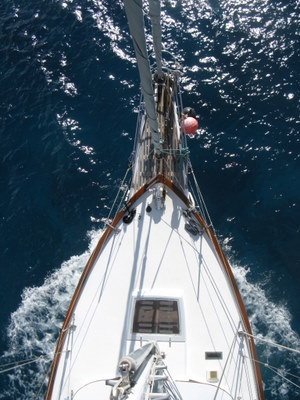 |
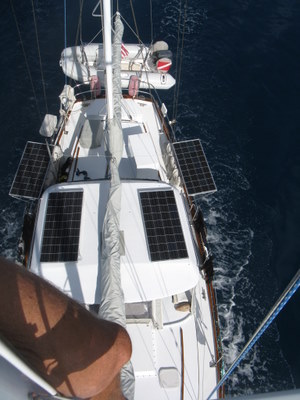 |
Fare (June 28 to July 1). It was really no problem for us to have another day in Fare because we wanted to do some sightseeing from here. Even though it was a holiday, we found a bike rental place that was open, and we rented bikes and went for a ride. Our plan for the day was to head to a large marae site near the town of Maeva, which was about 6 km east of Fare. The scenery was beautiful, the road was flat, and it was an easy ride along the north coast of Huahine-Nui. We spent about an hour exploring the archeological ruins, including a short hike up into the jungle. Papayas were growing wild and were plentiful, and we picked a couple to take home with us. After we'd seen enough of the marae, we were still feeling energetic, and we continued on another 5 km to the village of Faie on the east coast. We found a place to have an ice cream, and cruised through the small town on our bikes. When we got to the other side of town, there was a hill with a 15% grade for 2 km, and at the top was supposedly a nice look-out. We were riding one-speed bikes, so riding up this hill was out of the question. We had the bright idea of pushing the bikes up the hill, and then coasting back down, but after pushing the bikes a couple hundred feet uphill, Jan dismissed this as a bad idea. We then hopped on the bikes and started coasting down the hill, but in short order, Rich's brakes locked up, so he had to walk his bike back down the hill, too. As we cruised through Faie, we saw a sign for something that appeared to be a tourist attraction since there was a drawing of a camera on the sign. The sign was in French, and the only word Jan recognized was "sacrée", which means "sacred". We assumed it was a church and didn't bother to check it out. Since we hadn't intended to bike this far, we didn't read up ahead of time on the village of Faie, and we missed the sacred blue-eyed eels, which are the main attraction here. Darn!
|
|
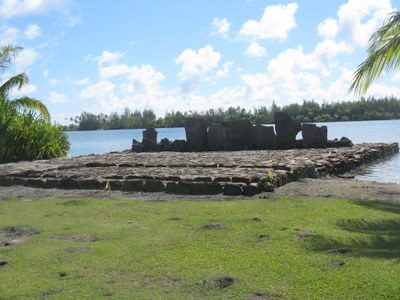 Marae near Maeva on Lake Fauna Nui |
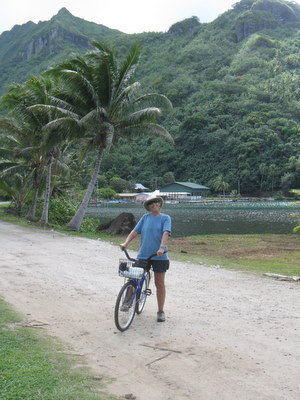 The blue-eyed eels are probably just behind Jan in this photo |
Rich thought the ride back to Fare was a piece of cake, but Jan was losing steam. As we got back to town, we still had an hour before we needed to return the bikes, and Rich wanted to ride a little further to a small bay just south of town, so we continued on. Rich was out ahead of Jan, and as we got south of town, we were pedaling along a pretty stretch of beach. Jan decided she would find a shady spot, sit down and relax for a bit and then ride back with Rich when he turned around. Rich apparently had the same idea, as when she found that nice shady spot, Rich was already taking advantage of it! We hung out and watched some locals swimming and paddling on surfboards - they actually stand on the board and use a paddle, which takes some balance and skill. We saw a young mother paddling around with her small child riding on the surfboard with her. The kid was having fun until Mom accidentally whacked him in the head with the paddle. Ouch! We finally lifted our weary bones off this beach and headed back to Fare. The bike shop had closed at noon due to the holiday, but the owner was meeting us back at the store at 5 p.m. He was fairly prompt, and we returned the bikes and headed to New Te Marara, a beach bar with "Happy Hour" every day from 5 to 6 p.m. Their happy hour beer prices were the best in French Polynesia, and Hini, the woman who served the beer was a sweetheart. We ordered up a couple of large draft beers and enjoyed the sunset.
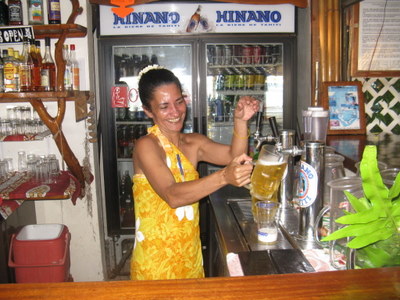 Hini serving up an ice-cold Hinano |
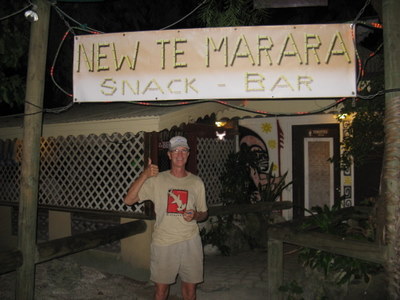 Rich liked Happy Hour here |
The next morning we paid the bill for our radio at the bank and made our final visits to the veggie stands and supermarket. That afternoon, we hitchhiked out to the airport to pick up our radio. Since there isn't a good bus system on Huahine, hitchhiking is common and quite acceptable. The man who brought us back from the airport actually drove past his destination to drop us off at the dinghy dock. Very nice! That evening, the Gromit family invited us over for dessert. Zoe loves to bake, and she made a delicious apple tort. Yum! We had a lovely time chatting, and before we knew it, it was way past our bedtime!
Passage from Huahine to Raiatea (July 1, 23 nm, 4½ hours). We dragged ourselves out of bed the next morning, and prepared to move on. We weighed anchor, waved good-bye to the Gromit family, motored out the pass and headed west toward Raiatea. With very little wind and flat calm seas, we motored the short distance, arriving in the early afternoon.
| Raiatea / Tahaa. Raiatea and
Tahaa are enclosed in the same lagoon, sitting just 3 km apart, and legend has
it that the islands were cut apart by a mythical eel. Raiatea is the
second-largest of the Society Islands (after Tahiti), and measures approximately 12 miles
north-to-south and 8 miles east-to-west. It is commonly believed
that migrations which colonized eastern Polynesia originated from Faaroa Bay on
Raiatea. Raiatea has a total population of about 12,000, and about 4,000
live in the town of Uturoa, which is the capital and administrative center for
the Leeward Islands. Tahaa's shape is fairly round and about 6 miles in
diameter. It is more rural and is known as the "vanilla island" because it
produces 70% of the territory's vanilla.
Uturoa, Raiatea (July 1-10). We arrived Raiatea in the early afternoon and anchored behind Ile Taoru just inside the Teavapiti Pass on the northeast side of the island. It was a Friday afternoon, and shortly after anchoring, we headed into Uturoa to find the hospital. Rich had a growth on the top of his hand, and we wanted to have it looked at by a doctor. We arrived at the hospital at 3 p.m., only to find that the doctors and staff go home at 2:30 p.m. on Fridays. But, the lady at the front desk was nice and suggested we go to the Emergency Room. We felt a bit sheepish going to the ER for something that was not an emergency, but they weren't busy, so we stopped in. At first, the ER nurse also wondered why we were there (he actually looked at us like we were nuts, and said "You came here for ziss??"), but after we explained that the lady at the front desk suggested we stop by, he became very friendly, brought us into an examination room and called the doctor to have a look. Both the ER nurse and doctor spoke English, which was extremely helpful! The ER doctor poked and prodded at the growth and told us he thought it would be a good idea to schedule an appointment with one of their surgeons to have it removed. The ER nurse wrote down for us the names of the two surgeons on staff at this hospital and sent us on our way (no charge). As we departed the hospital, we stopped back at the front desk to ask if we could schedule an appointment with one of the surgeons, but we were told to come back on Monday morning. We spent the next day catching up on a few chores - cleaned up the boat a bit and gave each other haircuts. Perhaps Rich missed his calling as a hairdresser! There was another boat in the anchorage, a Nordhavn powerboat named Shaka, and we invited the folks over for cocktails that evening. There were two couples on board - the owners Johann & Laurie and their guests, whose names we've unfortunately forgotten. Although Laurie was the only American-born of the four, they all spoke English. Their guests were French, but they lived in Chicago and had recently become U.S. citizens. It was quite ironic to find out that this couple had lived in Cincinnati for 6 years. They moved from Paris, France, to Milford, Ohio (what a change!), in 1984 for a business opportunity, and their daughter was born in Cincinnati. Small world! |
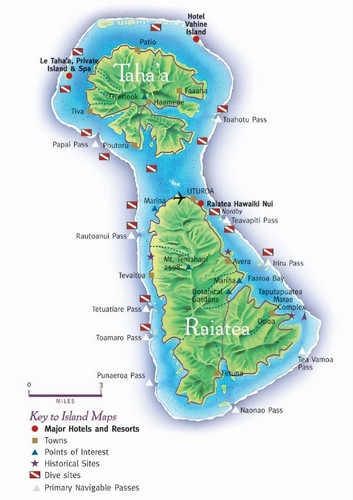 |
The following day, July 3, was our anniversary (12 years!). The winds were picking up from the southeast, which made our present anchorage uncomfortable. Since they were forecast to get stronger, we moved Slip Away to an anchorage off the northwest side of Raiatea, near the carenage (boatyard).
Bright and early on Monday morning (the 4th of July), we hopped in the dinghy and headed for the hospital. Uturoa was further away from our new anchorage, and the winds had picked up quite a bit. We were in the lee of the island for the start of the trip, but as we rounded the north side of Raiatea, the seas got pretty rough. Rather than bash all the way to the town wharf, we pulled into the Uturoa municipal marina, found a place to tie up the dinghy and walked to the hospital from there. We got to the hospital at 7:30 a.m., took a number and waited our turn. We were number 3 in line, so we didn't wait long, and when we were called to the window, Jan explained to the check-in lady in her broken French that Rich needed an appointment ("rendezvous") with a surgeon to remove this growth on his hand. (As she was explaining, of course, Rich was showing his hand and pointing.) The check-in lady told us that the surgeon was on vacation this week, and we would need to come back next week. Since we knew they supposedly had two surgeons on staff, Jan asked if both surgeons were on vacation, and the woman told her "yes." We thought it was a bit strange that both surgeons were on vacation, but we weren't sure what to do. The check-in lady then told us we could go to the Emergency Room if we wanted, so off we go to the ER once more. The first nurse we spoke to at the ER didn't speak much English, and we were having a hard time explaining our predicament in French, so she went and got an English-speaking nurse. When we told this nurse what the check-in lady told us, she looked at us incredulously, and said "But this is a hospital! We have two surgeons, and only one is on vacation!" She brought us into the ER, called the surgeon, and within about 20 minutes, he came to see Rich. While we were waiting for the surgeon, the English-speaking nurse shared our story with the entire of the staff in the ER - she was quite flabbergasted about what the check-in lady told us. When the surgeon looked at the growth on Rich's hand, he agreed it should be removed and said he could do it in an hour, but we needed to go back to the check-in lady to do some paperwork. The English-speaking nurse escorted us back to the check-in lady, and it was good entertainment to watch the exchange between these two women - with the nurse, hands on hips, effusively scolding the check-in lady for what she had told us, and the check-in lady being totally unapologetic. In the end, we did our paperwork and waited about three hours until the surgery room was ready. (Fortunately, both of us had brought a book to read while waiting.) The surgeon cut the growth off Rich's hand, sewed him back together with 8-10 stitches, and sent the growth off to the lab in Papeete for analysis. A week later we came back to the hospital to pick up the results of the lab test, which indicated it was a squamous cell carcinoma - not great news, but the surgeon had gotten clear margins all around, so all was well. Total cost about $140 - interesting that the lab test cost almost $100, but the surgery was just over $40.
After Rich's surgery, we had a couple of windy and rainy days, which gave him some time to hang out on the boat and let the hand heal. But, it wasn't all rest and relaxation. On one of those days, we and another boat captain spent a couple hours rescuing a sailboat whose anchor was dragging. It was quickly drifting toward the reef, so we hopped in our dinghies and used them to move the sailboat to a mooring. The boat belonged to a French guy who was working at the boatyard. Apparently he didn't appreciate our efforts, as he never even stopped by to say thank you.
|
|
|
The anchorage near the boatyard wasn't particularly appealing, but it offered fairly good protection from the blustery weather, and we were in a good place because we also needed some assistance with an outboard repair. Our outboard ran, but we had an exhaust and oil leak. The mechanic at the Raiatea Carenage advised us we needed to replace a gasket. He did not have it in stock, but he could order it from Papeete. This was on a Friday, and he told us the part would come in on Monday, and he could do the repair on Tuesday. So, we now had a few days to go have some fun.
July is the month of French Polynesia's Heiva festival, which has its origins in a pagan festival marking the southern hemisphere solstice. Last year, we were in the Marquesas for Heiva, and we thoroughly enjoyed the traditional Polynesian dancing performances. All of the islands in French Polynesia have dancing exhibitions during Heiva, and in most of the Society Islands, it is a competition between the local villages. The area where the dancing was held was close to Uturoa and too far away for a nighttime dinghy trip from the boatyard anchorage, but the weather was starting to settle down, and we were able to move Slip Away to an anchorage closer to town. Our friends Mike & Sue on Infini had recently arrived in Raiatea, and on a Saturday night, we all went ashore and watched a performance of dancers from the village of Apooti (coincidentally the village where the boatyard is located). Raiatea's dancing performances were bigger productions than those we saw in the Marquesas, with more lavish costumes and a larger venue, and some singing performances in addition to the dancing. One was not better than the other - just different - and we thoroughly enjoyed the performances we saw that evening.
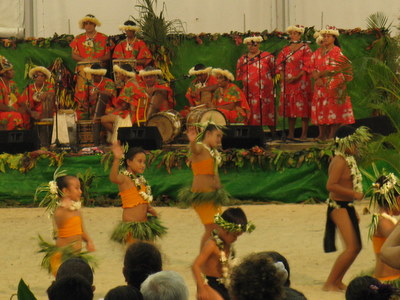 Dancers in training provided the warm-up |
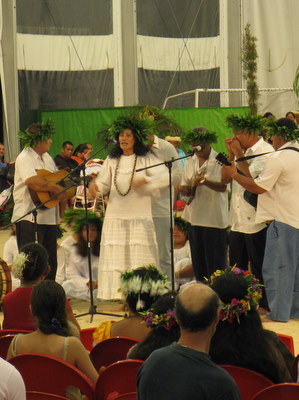 The Singing Performance |
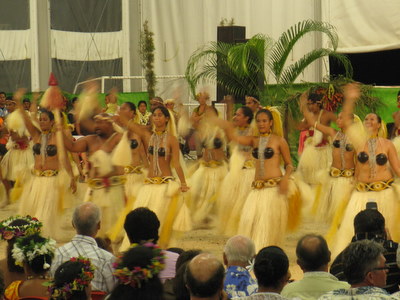 The Main Attraction |
Ile Naonao. (July 10-11). The next morning, Infini and Slip Away left Uturoa and motor-sailed down the east coast of Raiatea, following the lagoon inside the barrier reef, to Ile Naonao off the south end of the island (17 nm, 3 hours). Raiatea is mountainous, and the scenery was beautiful along the coast. Ile Naonao lies off the south end of Raiatea, a flat islet covered with palm trees and edged in a white sand beach. We found very good snorkeling in clear water on the reef along the south and west sides of Ile Naonao, and we spent the afternoon with our faces in the water. Very nice!
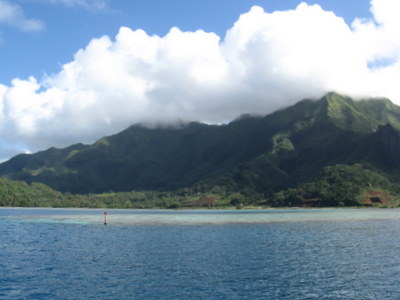 Navigating the marked channel along the beautiful southeast coast of Raiatea |
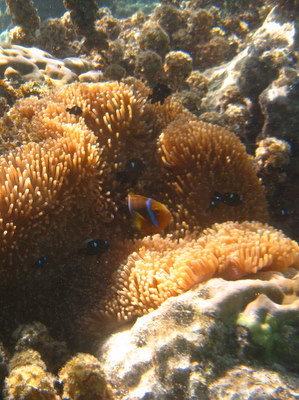 Anemone-fish and damsel-fish co-habitating in an anemone |
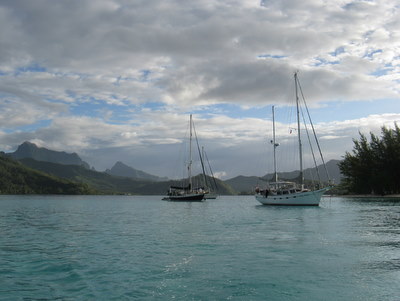 Anchored at Ile Nao Nao with the south side of Raiatea in the background |
Baie Faaroa (July 11). The following morning, Slip Away and Infini weighed anchor again and headed north to Faaroa Bay (12 nm, 2½ hours), where we wanted to do a river tour with a guide named "James." We anchored in the bay, and the four of us climbed in Slip Away's dinghy and motored toward the mouth of the river where we hoped to find James. A guy waved to us to follow him, but this guy's name was Tony. Shortly thereafter, James paddled over on his kayak, and he was happy to guide us up the river, but Tony seemed to think he had claimed us. We ended up with both James and Tony accompanying us on the river tour, which wasn't an ideal situation, but we saw some beautiful scenery. The river flows through a plantation, and James gave us some bananas and coconuts to take home with us. Another good day!
After the river tour ended in the early afternoon, we and Infini both moved on to other anchorages. Infini found a nice spot nearby along the barrier reef, but we needed to get back to the boatyard for our outboard repair appointment the next morning, so we carried on (11 nm, 2 hours). As we approached Uturoa, we picked up a hitchhiker - a young man in an outrigger who paddled into Slip Away's wake to get a faster ride home.
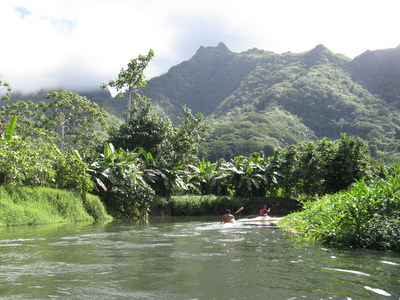 James & Tony leading us down the river |
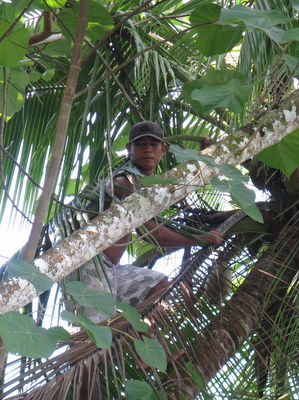 James climbing a coconut palm |
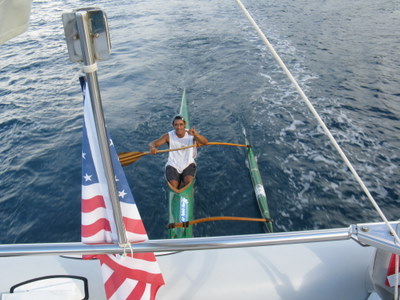 Our hitchhiker |
On Tuesday morning, we dinghied into the boatyard bright and early. Our parts had arrived from Papeete, and the mechanic loaded our outboard in his truck, took it to his shop for repair and returned it to us with the new gasket installed later that afternoon. Cross that one off the to-do list! We had one more chore to do at the boatyard, and that was to fill our propane tank. The next morning, we brought in our tank, and the yard used a gravity-feed system to fill it. It was by far the most expensive propane we've ever bought - $63 to fill a 20 lb. tank. Ouch!
Uturoa (July 13-16). By now, Rich's hand was mostly healed, and with our repaired outboard, we were free to do what we wanted. We were coming up on the 14th of July, which is the French Bastille Day commemorating the fall of the Bastille in Paris at the height of the French Revolution. In French Polynesia, Bastille Day gets rolled into the Heiva celebration, with a parade and other events throughout the day. The weather was settled, and we once again anchored Slip Away off the town of Uturoa, so we could dinghy ashore to watch the parade and attend another dancing exhibition. This dancing performance was of the top solo dancers from each of the villages on Raiatea, and it was especially fun, because each of the dancers had their hometown fans present, and the crowds really cheered them on.
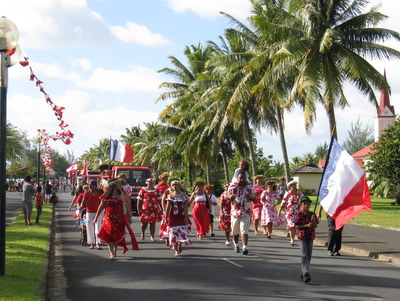 Here comes the parade! |
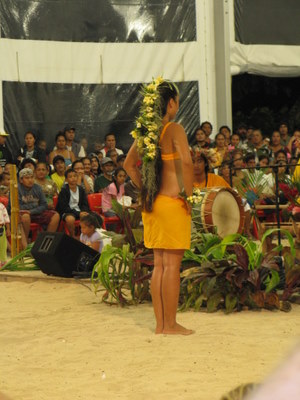 One of the soloists ready to perform |
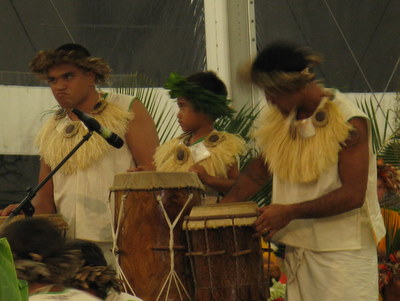 This little bongo drummer was a crowd pleaser |
It was during this time that we also found an outstanding hike on Raiatea - Mt.Tapioi - which rises 294 meters (965 feet) behind Uturoa. We hiked it twice - once with just the two of us and a second time, with Mike & Sue from Infini and Jason from YOLO. Both days were sunny, and the views from above were gorgeous! We could see Raiatea and Tahaa, as well as Bora Bora and Huahine.
|
|
Raiatea to Tahaa. After the Bastille day festivities, Slip Away, Infini and YOLO (which stands for "You Only Live Once") headed north to Tahaa (pronounced ta-HA-a). We weighed anchor in Uturoa, unfurled our headsail, and sailed up to Hurepiti Bay on the west side of Tahaa (8½ nm, 2 hours). How nice that we could sail to another island without ever leaving the lagoon!
Hurepiti Bay (July 16-18). After the hustle and bustle of Uturoa, we found Hurepiti Bay to be very peaceful and quiet and a lovely place to walk or hike. On the afternoon that we arrived, we, along with Mike & Sue from Infini and Karen & Jason from YOLO, took a nice walk, admiring the lush green foliage, flowers, fruit trees and vanilla plants that lined the road.
YOLO left for Bora Bora the next morning, and we and Infini planned a longer walk - up and over the ridge of the island to Haamene Bay on the east side. A local couple, Alain and Christina, who run a tour company called "Vanilla Tours", were letting us use their dock to land our dinghies, and when we went ashore that morning, we took some freshly baked chocolate chip cookies to say thank you. They were just getting in their truck to drive over to Haamene Bay and offered us a lift, which we were happy to accept.
Alain and Christina dropped us off in the small village of Haamene at the head of the bay, and we set off walking along the south shore. We walked a couple of miles and were looking for a cut-off road that would take us on a loop trail, but we were having trouble finding it. We stopped in front of a beautiful home/guesthouse named "Tiare's Breeze" wondering if we should ask for directions. Before we could knock on their door, the family who lived here came out to greet us and invited us in. We met Virginie & Tamahere and their lovely 13-year old daughter Tiheni. Mom & Dad are schoolteachers and the whole family speaks English fluently. They showed us their home, which they built themselves, as well as their dock and their guesthouse on top of the hill overlooking the bay. The whole place was lovely, and the family could not have been nicer. Before we departed, they gave us some fresh basil and mint, which was growing in their yard, and put flowers in our hair. What an incredible encounter! Their website is www.tiarebreeze.com.
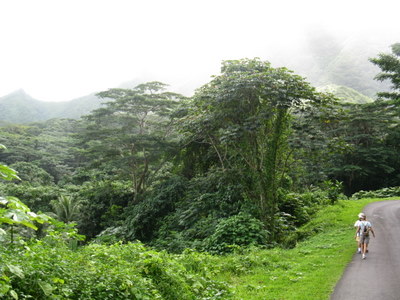 Mike & Sue from Infini walking on the lush island of Tahaa |
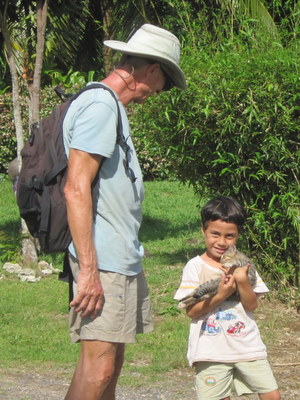 Rich makes a new friend |
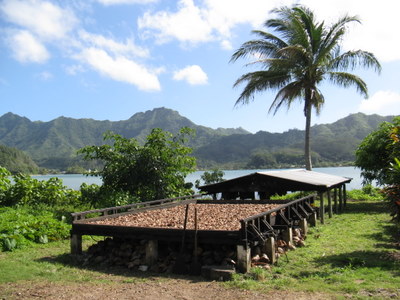 Copra drying on Tahaa |
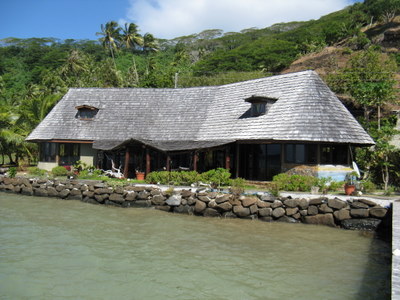 The beautiful home of the proprietors of Tiare's Breeze |
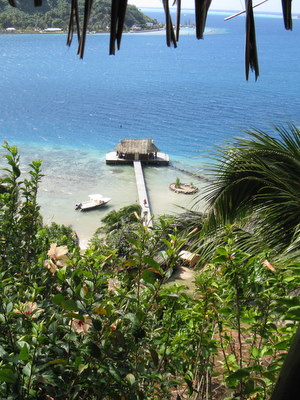 View of Tiare's Breeze dock from their guesthouse on the hill |
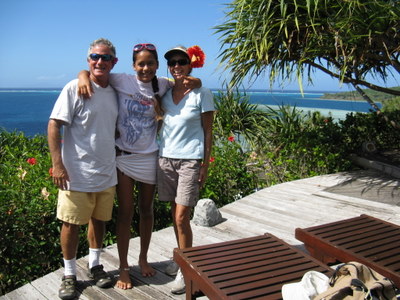 Mike & Sue from Infini with 13-year old Tiheni |
After leaving Tiare's Breeze, we walked back toward the Haamene village. One of the Tiare's Breeze dogs adopted us, and followed us almost all the way back to the village. We tried repeatedly to send the dog home, but he wouldn't listen - maybe he didn't understand English! Sue from Infini was eventually successful, drawing on her experience of working on a wolf preserve many years ago, she finally distracted him and headed him off in the right direction - very clever! When we got back to the village, we found a small restaurant and decided to stop for a cold drink. Sitting at the next table, we recognized a couple we had met on Tapioi Hill a few days prior. They had just ordered dessert, and the next thing we knew, we were asking for menus and ordering profiteroles for us too! After our mid-afternoon sweet fix, we hiked over the ridge to the west side of Tahaa, and headed home to our boats in Hurepiti Bay.
| Tapuamau Bay (July
18-20). After Hurepiti, we moved a short distance north to Tapuamau Bay (5 miles, 1
hour). This anchorage has great holding, but it is deep - nothing like
dropping your anchor in 70 feet of water! There is a commercial dock in
this bay and some boat traffic, and we could also hear cars on the road, which
ran along the edge of the bay, so this was a less peaceful place for us than our
previous anchorage.
From this bay, we were able to dinghy to the Coral Gardens snorkel site, which lay next to Ile Tautau, an island along the barrier reef. This snorkel spot was highly recommended, and we enjoyed the pretty corals and very good fish life, but it was quite shallow, and there were a lot of black sea urchins - fortunately, we didn't bump into any of them! From Tapuamau Bay, we had a beautiful view of Bora Bora's peaks, especially at sunset, and they were calling to us. But, we had a few last errands to run before we could head over there. We wanted to pick up a few items at the grocery store, but more importantly, we needed to top off Slip Away's diesel tank, which was running quite low. Cruising yachts in French Polynesia can buy diesel duty-free, which is a nice savings for us, but duty-free fuel can only be purchased from certain fuel docks. The fuel dock in Tapuamau Bay sold duty-free diesel, but their dock was in a very small bay with a narrow entryway, and there didn't appear to be enough room to safely maneuver Slip Away. So, the best option for us was to return to Raiatea. |
|
Tapuamau to Uturoa to Hurepiti Bay (July 20). We wanted to run our errands in a day, so we got an early start, leaving Tapuamau Bay at about 7:30 a.m. We arrived at the Total fuel dock in Uturoa at about 10 a.m., but we had to wait for a ferry to finish fueling, and then a couple of smaller boats darted in and tied up at the dock ahead of us. There was not enough room on the dock for us and a small boat, and the area for maneuvering around this fuel dock was also pretty tight, so we just tried to hover as close as possible, motoring in circles and waiting. We finally tied up at the fuel dock at about 11, took on 158 gallons of diesel (our tank capacity is 168 gallons!) and 10 gallons of gasoline, topped off our water tank and off-loaded our waste oil. Departing the dock with 15 knots of wind pushing us against it and little room to maneuver was a challenge, but we got away with no problems (although at $4.32 US per gallon of diesel and $7.30 US per gallon of gasoline, our bank account suffered some damage!).
From the fuel dock, we went to the town wharf. Boats can tie up for free at the town wharf in Uturoa, and although we normally prefer to anchor, we thought it would be more convenient to be at the wharf to load up groceries than to anchor and dinghy in. Tying up at the wharf was more challenging than the fuel dock because there was no place to tie a spring line, no one on shore to help by taking a line, and the wind was blowing us off the dock. But we did it - not perfectly - but successfully. There was a charter yacht trying to tie up right behind us and having some problems (came close to hitting us, which made our hearts stop!), so after tying up Slip Away, we helped them get secured too.
Uturoa has three well-stocked grocery stores, and we had done a significant amount of provisioning during previous trips into town, topping up our fridge, freezer and storage lockers so we would be set for the next few months. But we still had a few items on our list - a case of beer, some fresh fruits and veggies, and a couple other staple items. Although we could buy this stuff in Bora Bora, we'd heard everything was more expensive there, so we thought it best to pick it up here. We grabbed a quick sandwich in town for lunch, hit all three grocery stores and then loaded the stuff on to Slip Away. We could actually bring the grocery cart out on the dock, which was quite handy. Departing the dock was more difficult than we anticipated, but we got off and were on our way.
When we left Uturoa, we headed back to Tahaa and Hurepiti Bay. Hurepiti was our favorite spot on Tahaa, and it was right next to the pass we would exit the next morning on our way to Bora Bora. We dropped our hook in Hurepiti shortly after 3 p.m. It had been a hectic and somewhat stressful day - since we don't dock the boat often, that exercise always causes us angst. But, we had a successful day, accomplishing everything we had set out to do. That evening, this peaceful bay was especially sweet.
Some of the beautiful flowers we saw on Tahaa:
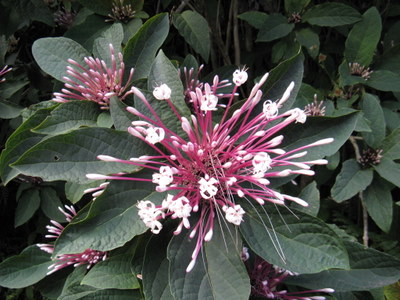 |
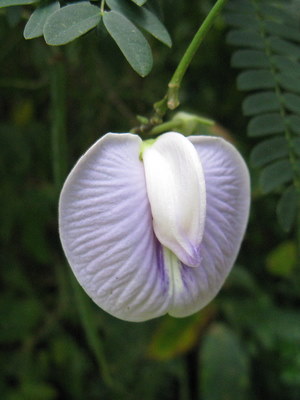 |
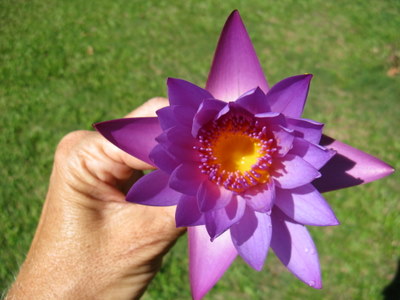 |
Passage from Tahaa to Bora Bora (July 21, 26½ nm, 5½ hours). The passage from Tahaa to Bora Bora was not a long one, but we were expecting light winds, so we got an early start, weighing anchor at 7:30 a.m. We motored out the pass, and winds were blowing at 8-10 knots from the northeast - on our beam. We raised the main and mizzen, unfurled the headsail and cut the engine. We were sailing along quite pleasantly when Rich saw some bright colors of a large fish off the beam of the boat. Next thing we knew, our fishing line was going off. It was a dorado, and he had taken our lure! While Rich was reeling in the fish, Jan was trying to slow the boat down to make it easier for him, but the winds had built to 16-18 knots. She finally doused the mizzen and furled the headsail, and Rich landed a beautiful dorado - probably 20-25 lbs., the first we had landed in a long, long time. That was a good way to start out the day!
After landing and cleaning the fish, we reefed the mainsail, unfurled the headsail and continued on our way to Bora Bora. The Te Ava Nui pass on the west side of the island is the only navigable pass into Bora Bora's lagoon, and as we approached it, we turned on the engine and motored in. What a beautiful sight!
|
|
|
| Bora Bora.
Bora Bora is probably the most famous of the French Polynesian Islands. It
is spectacularly beautiful with dramatic peaks on the main island which are the
result of a collapsed volcano crater and a reef with numerous motus (islets) which
surrounds it and encircles a lagoon with incredibly blue water. It also
has a few smaller
high islands inside the lagoon, and gorgeous white sand beaches. When
James Michener wrote "Tales of the South Pacific", he modeled his fictitious
Bali Hai after Bora Bora. In World War II, the U.S. built a naval base on
Bora Bora, and there are still remains of huge naval guns installed here to
defend against a potential Japanese attack. The U.S. also built an airport on Motu Mute, one of the islets along the barrier reef, and that airport
(with a few improvements) is still in use today. Bora Bora is a huge tourist destination, and
although there are no high-rise hotels, there is no shortage of over-the-water
bungalows. We came here on our honeymoon in 1999, and it was very
exciting for us to sail into the lagoon here on our own sailboat.
Vaitape (July 21 to 23). A large number of the cruising yachts at Bora Bora were moored off the main town of Vaitape. The previous managers of the Bora Bora Yacht Club were in the process of opening a new yacht club called the Mai Kai Marina, and they were offering free mooring balls for the month of July. Needless to say, those mooring balls were in high demand, and by the time we arrived, none were available. We wanted to spend a couple of days in Vaitape to see a Heiva dancing performance, so we anchored nearby. Anchoring was a challenge because it was deep - we anchored in 80 feet of water - and gusty winds came down the side of the mountain and sent boats sailing around in a variety of directions. It took us a few tries, but we eventually found ourselves a nice spot. The next evening, we watched a dancing performance put on by Bora Bora's competition winners. It was a beautiful show - the biggest and most lavish production of all that we'd seen. We stayed for most of the show but ducked out during the last dance when it started pouring down rain. |
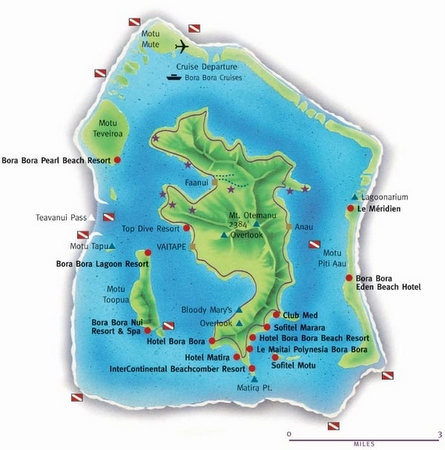 |
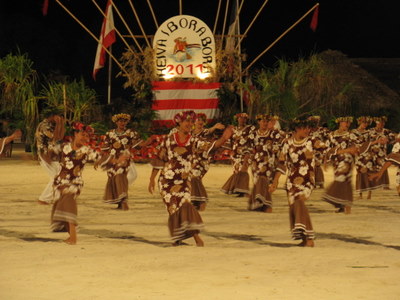 The top dancing team on Bora Bora |
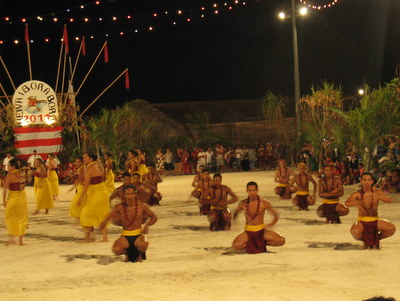 Beautiful costumes and great traditional dancing |
Motu Piti Aau (July 23 to 26). After the dancing performance, we were eager to leave Vaitape and find a nicer anchorage. There's a marked channel in the lagoon which runs from west side, up and around the north side to the east side of the main island, and the next morning, we, Infini and YOLO headed in that direction. There were a couple of tricky and shallow spots along the way, but we followed the charts, kept a lookout on the bow, and made it to our destination with no problems. On the east side, we anchored off Motu Piti Aau - a great anchorage with 20 feet of depth, a white sand bottom and clear blue water. Shortly after dropping the hook, we were all swimming in this beautiful clear water.
We spent a couple of days anchored off Motu Piti Aau and found some excellent snorkeling on the south side of Ile Piti uu Uta (better known as the Sofitel Motu), an island inside the lagoon. On another day, Mike & Sue from Infini joined us as we dinghied ashore to Le Maitai Polynesia, the hotel where we spent six days of our honeymoon in 1999. Le Maitai Polynesia is one of the smaller resorts on Bora Bora, but it is beautifully maintained and as nice as we remembered. We found our over-the-water-bungalow and enjoyed a drink and dessert (splitting profiteroles and coconut crème brûlée - yum!) at their waterfront cafe.
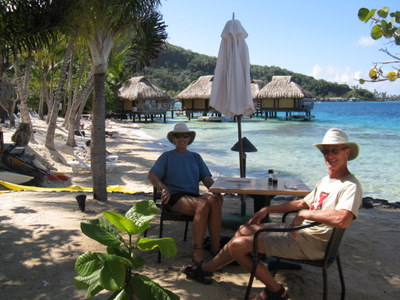 The two of us at Le Maitai Polynesia beach cafe with our honeymoon bungalow in the background |
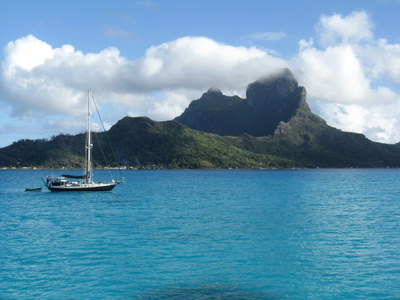 Infini plying the beautiful blue waters of Bora Bora's lagoon |
Motu Tupe (July 26 to 28). From Motu Piti Aau, we moved just 3½ miles north and anchored off Motu Tupe (by Le Meridien Hotel). Here, we were conveniently anchored for a dive site called "Manta Dance." We had a dive guidebook, which described the location, as well as info from other cruisers, so it wasn't hard to find the dive site. We dove the site twice, and snorkeled the shallower stuff once. It was a great spot with beautiful corals and excellent fish life. This is the only place we've ever seen a juvenile Pacific Sailfin Tang, and we saw three of them! On our first dive, we also saw a school of spotted eagle rays - probably 20-25 of them, which was quite a sight. However, the mantas were somewhere else. We didn't see a single one.
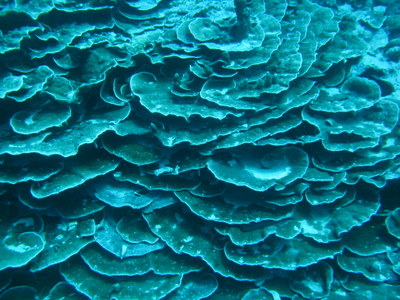 Fragile Montipore corals at the Manta Dance dive site |
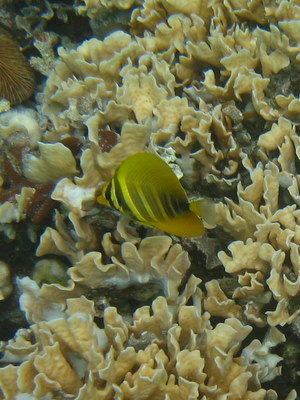 One of our Juvenile Pacific Sailfin Tang sightings |
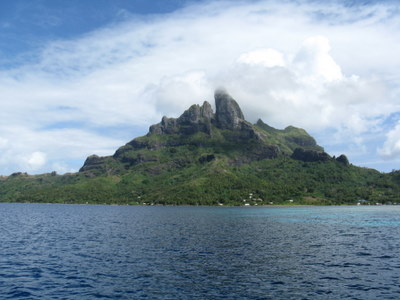 Another side of Bora Bora |
Unfortunately, our time was running out in French Polynesia. Our visa was expiring on July 31, which was a Sunday, and we needed to get back to Vaitape to do our final check-out paperwork with the authorities. We motored back to Vaitape, once again dropped our anchor in 80 feet of water, visited the Gendarmerie and post office to complete our departure paperwork, and stopped at the grocery stores for some final provisions. There was unsettled weather forecast for the next few days, so we were planning to find a secure place to anchor and leave when that passed. After our errands were run, we motored over to the west side of Motu Toopua, an island inside the lagoon, and dropped our hook.
Motu Toopua (July 28 to August 2). The anchorage at Motu Toopua was near the Te Ava Nui pass, and the unsettled weather brought big swells on the outside. We didn't feel the swells in the anchorage, but it made for a strong current inside the lagoon. We were tucked in a good place, though, and the motu offered protection from the strong southeast winds which blew over the next couple of days.
Although the weather was unsettled, we were able to get off the boat and visit one last place we wanted to go on Bora Bora - the famous Bloody Mary's Restaurant & Bar. We had wanted to eat lunch at Bloody Mary's when we were here on our honeymoon, but we went on our last day on the island, which was a Sunday, and they are closed on Sundays. So, this time we went on a Friday. It was a couple miles to Bloody Mary's from our anchorage at Motu Toopua, but we were able to dinghy to the restaurant, and the ride wasn't as rough and wet as we thought it might be in the windy weather. We, along with Mike & Sue from Infini, Kathy & Gil from Endorphin, and Mike, Irene and another crew member from This Side Up met at Bloody Mary's for lunch. The two of us ordered Bloody Mary's and burgers, which were quite tasty, and the ambiance was great fun!
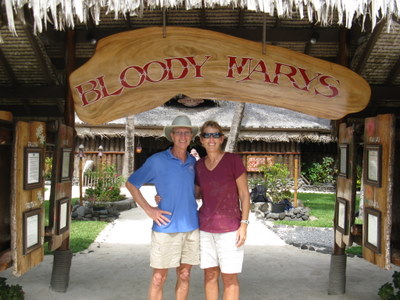 The two of us at Bloody Mary's |
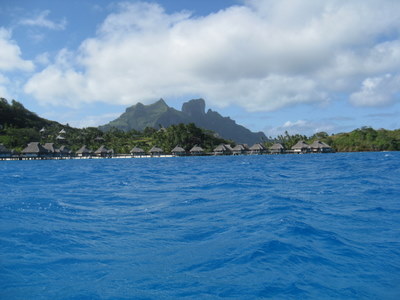 The Sheraton Bora Bora Nui Resort on Motu Toopua |
We spent a couple more days anchored off Motu Toopua waiting out the blustery weather. At one point, the wind switched around to the north, which opposed the flow of the current, and that sent the boats in our anchorage sailing around in different directions. We were down below working on some chores when we heard a clunk, and we looked out to find that Infini and Slip Away's bows had "kissed." There was no damage to Infini, and the encounter actually straightened out a bent anchor trough on Slip Away, so no problem! Neither of our anchors had dragged - it was just the opposing winds and currents that caused us to sail in opposite directions and hit. To avoid another encounter, we weighed anchor and headed to another bay a little further south. This bay was less crowded, and it was a nice place to hang out for our last couple of days in Bora Bora.
Visiting Bora Bora on Slip Away was such a treat! It's quite a different experience coming here on our boat versus staying in a hotel. It seemed to us that there are more hotels on Bora Bora than when we were here in 1999 (and unfortunately for them, occupancy rates are way down due to the bad economy). In some ways, this development detracted from our enjoyment on this visit because there was a lot of tour and taxi boat traffic in the lagoon. However, we understand why this island is so popular - both the island and the lagoon are stunningly beautiful. And, despite the busy-ness and wakes from the local boats, we had a great visit and are glad we had the opportunity to come back.
It was now time for us to leave French Polynesia in our wake. Both of us were very happy that we came back and spent six more months in these lovely islands. We definitely realize how lucky we are! We had an opportunity to see more of French Polynesia than most people, and yet there was still so much that we missed. We could have spent even more time diving in the Tuamotus and more time hiking, snorkeling and diving the Societies. There were atolls and islands we still hadn't visited, and we certainly hadn't seen "everything" on the ones that we did.
That said, we were ready move on. We were excited to sail to our next destination - Suwarrow Atoll in the Cook Islands. And, Tonga and New Zealand still lay on the horizon for this year, so we needed to get going. On the morning of August 2, we weighed anchor, motored out the pass and then set our sails and headed west.
